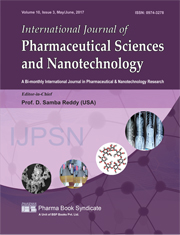Mechanistic Evaluation of Antinociceptive Effects of Bioactive Guided Fractions of Barleria prionitis
DOI:
https://doi.org/10.37285/ijpsn.2017.10.3.3Abstract
Barleria prionitis Linn.(Acanthaceae) is a prickly shrub and traditionally whole plant is used as anti-inflammatory, expectorant, analgesic, diuretic, antirheumaticand antidiabetic. This study was conducted to investigate the antinociceptive and CNS depressant activity of ethanolic extract and the fractions of B. prionitis in mice. Ethanol extract and its fractions were tested at a dose of 200 and 400 mg/kg. Ethanol, petroleum ether and chloroform fractions demonstrated significant antinociceptive activity at 400 mg/kg and significantly increased the latency in hot plate test and the action was antagonised by naloxone, indicating a potential opioid-like mechanism. In conclusion, the ethanol, pet ether and chloroform fractions of B. prionitis markedly demonstrated the antinociceptive action. The CNS depressant and good protective effect on pain stimuli suggest that the possible mechanisms appear to be due to involvement of opioid and/or peripheral receptors.
Downloads
Metrics
Keywords:
Antinociceptive activity, analgesia, morphine, naloxone, Barleria prionitisDownloads
Published
How to Cite
Issue
Section
References
Boisser JR and Simon P (1964). Dissociation dedeux compasanates dansle compartment investigationde lasouris. Arch Int Pharmacodyn 147: 372-388.
Calixto, J.B (2005). Twenty-five years of research on medicinal plants in Latin America: a personal view. Journal of Ethanopharmacology 100: 131-134.
Chen JL, Blanc P, Stoddart CA, Bogan M, Rozhon EJ, Parkinson N, Ye Z, Cooper R, Balick M, Nanakorn W and Kernan MR (1998). New iridoids from the medicinal plant Barleria prionitis with potent activity against respiratory syncytial virus. J Nat Prod 61: 1295-1297.
Collier HO, Dinneen LC, Johnson CA and Schneider C (1968). The abdominal constriction response and its suppression by analgesic drugs in the mouse. Br J Pharmacol Chemother 32: 295-310.
Damtoft S, Jensen SR and Nielsen BJ (1982). Structural revision of barlerin and acetyl barlerin. Tetrahedron Lett 23: 4155-4156.
Eddy NB and Leimbach D (1953). Synthetic analgesics. Dithienylbutenyl and Dithienyl butylamines. J Pharmacol Exp Ther 107: 385-393.
El-Emary NA, Makboul MA, Abdel-Hafiz MA and Ahmed AS (1990). Phytochemical study of Barleria cristata L. and Barleria prionitis L. cultivated in Egypt. Bull Pharmaceut Sci Assiut Univ 13: 65-72.
Faden AI (1988). Role of thyrotropin-releasing hormone and opiate receptor antagonists in limiting central nervous system injury. Adv Neurol 47: 531-546.
Ghosh MN (2005). Fundamentals of esperimental pharmacology. 3rd ed. Calcutta: Hilton and company 218-29.
Gupta AK, Neeraj Tandon and Madhu Sharma (2006). Quality standards of Indian medicinal plants, editor. 1st Ed. New Delhi: Indian Council of Medical Research 4: 36.
Katzung BG (1995). Basic and clinical pharmacology. 6th ed. Applton and Lange, Stanford, Conn, USA.
Kiritikar KR and Basu B.D (1996). Indian medicinal plants. 3: 1887.
Koster R, Anderson M and de Beer EJ (1959). Acetic acid for analgesic screening, Fed Proc 18: 412.
Kulkarni SK (1999). Hand book of experimental pharmacology 3rd ed New Delhi: Vallabh Prakashan 117-119.
Moitra SK, Ganguly AN, Chakravarti NN and Adhya RN (1970). Chemical investigation of Barleria prionitis. Bull Calcutta Sch Trop Med 8: 7.
Oomanchan MM (1991). Ethno-botanical and conservation aspects of medicinal plants of Madhya Pradesh. In J of Pure and Appli Sci pp: 6.
Pullaiah T and Chandrasekhar Naidu K (2003). Antidiabetic plants in India and herbal based antidiabetic research. Regency publications, New Delhi pp: 99.
Sani Mohd MH, Zakaria ZA, Balan T, Teh LK and Salleh MZ (2012). Antinociceptive activity of methanol extract of Muntingia calabura leaves and the mechanisms of action involved. Evidence based complementary and alternative medicine pp: 1-10
Sigemond R and Cadmus RG. Analgesic activity of aqueous ethanolic extract of whole plant of Leucas hirta in Swiss Albino mice, Proc Soc Exp Biol Med 95: 72.
Singh B, Chandan BK, Prabhakar A, Taneja SC, Singh J and Qazi GN (2005). Chemistry and hepatoprotective activity of an active fraction from Barleria prionitis Linn. in experimental animals. Phytother Res 18: 391-404.
Taneja SC and Tiwari HP (1975). Structures of two new iridoids from Barleria prionitis Linn. Tetrahedron Lett 24: 1995-1998.
Vat ZR, Filho VC, Yunes RA and Calixto JB (1996). Antinociceptive action of 2-(4-bromobenzoyl)-3-methyl-4,6-dimethoxy benzofuran, a novel xanthoxyline derivative on chemical and thermalmodels of nociception in mice. J Pharmacol Exp Ther 278: 304-312.
Witkin LB, Heubner CF, Galdi F, O’keefe E, Spitaletta P and Plummer AJ (1961). Pharmacology of 2-amino-indane hydrochloride (Su-8629): A potent non-narcotic analgesic. J Pharmacol Exp Ther 133: 400-408.
Yadav AV, Kawale LA and Nade VS (2008). Effect of Morus alba L. (mulberry) leaves on anxiety inmice. Indian J Pharmaco l40: 32-36.
Zimmermann M (1983). Ethical guidelines for investigating experi-mental pain in conscious animals. Pain 16: 109-110.






